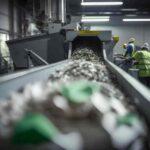Advantages of recycling aluminum
Aluminum is a material that, if not recycled, would impose the production of new objects from raw aluminum ore, with a considerable expenditure of energy and resources. Recycling aluminum thus saves energy and reduces the extraction of new raw materials, presenting a twofold advantage. Unlike other materials, such as plastics, which are often cheaper to produce from virgin raw material than to recycle, aluminum is a cost-effective choice for recycling. Aluminum also has the advantage of not corroding, unlike other metals such as iron, which turns to iron oxide-or rust-if left unattended. While iron requires expensive treatments to remove oxygen and be able to be reused, aluminum can simply be melted down and reformed into new products. This property makes aluminum recycling particularly efficient and cost-effective, solidifying its central role in environmental sustainability programs.
The World of Aluminum: Properties and Applications
Aluminum, a versatile and lightweight metal, has revolutionized various industries with its exceptional properties and wide-ranging applications. Its low density, high corrosion resistance, and excellent thermal conductivity make it an ideal choice for transportation, packaging, construction, and electrical industries. With a melting point of approximately 660 degrees Celsius, aluminum can be easily molded and shaped into intricate designs. It is also highly ductile and malleable, allowing manufacturers to create complex structures with ease. Furthermore, aluminum’s ability to conduct heat efficiently makes it a preferred material for heat sinks in electronic devices. Its non-toxic nature and recyclability further enhance its appeal in sustainable manufacturing processes. From aircraft construction to beverage cans, aluminum’s versatility and durability have made it an indispensable component in countless products we encounter daily. As technology continues to advance, the demand for this remarkable metal is only expected to grow, cementing its position as a vital player in the modern world.
Demystifying the Melting Point of Aluminum Scrap
Aluminum, a versatile metal known for its strength and lightness, has a melting point that has long fascinated scientists and engineers. But what about the melting point of aluminum scrap? Many wonder if it differs from that of pure aluminum. The answer is yes, it does. While pure aluminum has a melting point of 660 degrees Celsius, the melting point of aluminum scrap can vary depending on its composition. Aluminum scrap is typically made up of various alloys and impurities, which can raise or lower its melting point. For instance, aluminum cans have a lower melting point compared to other forms of aluminum scrap due to their alloy composition. Understanding the melting point of aluminum scrap is crucial in the recycling process, as it determines the temperature required for successful melting and casting. By demystifying this aspect, we gain a deeper appreciation for the complexities involved in recycling this valuable metal.
Why Recycling Aluminum is a Game-Changer for the Environment
Recycling aluminum is a game-changer for the environment. With its remarkable properties and wide range of applications, aluminum has become an essential material in our modern world. However, the extraction and production of virgin aluminum require vast amounts of energy and generate significant greenhouse gas emissions. This is where recycling comes in. By recycling aluminum, we can significantly reduce the energy consumption and emissions associated with its production. In fact, recycling aluminum requires only 5% of the energy needed to produce it from raw materials. Additionally, recycling aluminum saves valuable natural resources, as it can be recycled endlessly without losing its quality or properties. By choosing to recycle aluminum, we can contribute to conserving energy, reducing emissions, and preserving our planet’s resources. It is a simple yet powerful way to make a positive impact on the environment and move towards a more sustainable future.
Unlocking the Advantages of Recycling Aluminum
Recycling aluminum is not only a responsible choice, but it also offers numerous advantages. Firstly, recycling aluminum helps to conserve natural resources. Unlike other materials, aluminum can be recycled indefinitely without losing its quality. This means that by recycling aluminum, we can reduce the need for mining and extracting new raw materials, ultimately preserving our environment. Additionally, recycling aluminum requires significantly less energy compared to producing new aluminum from scratch. In fact, recycling just one ton of aluminum saves up to nine tons of CO2 emissions. Moreover, the economic benefits of recycling aluminum cannot be overlooked. The aluminum recycling industry creates jobs and contributes to local economies. Furthermore, with the growing demand for sustainable materials, recycled aluminum holds a competitive edge in the market. By unlocking the advantages of recycling aluminum, we can pave the way for a more sustainable and prosperous future.
Innovation and Sustainability: The Future of Aluminum Recycling
As the world becomes increasingly conscious of environmental issues, the future of aluminum recycling is set to be driven by innovation and sustainability. With the demand for aluminum continuously growing, it is essential to find efficient and eco-friendly ways to recycle this valuable metal. Advanced technologies are being developed to improve the recycling process, such as sorting techniques that can separate different types of aluminum scrap more effectively. These innovations not only increase the recycling rates but also reduce energy consumption and greenhouse gas emissions associated with aluminum production. Additionally, advancements in smelting technologies allow for lower temperatures and shorter processing times, contributing to energy savings. Furthermore, initiatives focusing on closed-loop recycling systems are gaining momentum, ensuring that recycled aluminum is used in new products, thus reducing the need for virgin materials. By embracing innovation and sustainability, the future of aluminum recycling holds great promise in preserving our planet’s resources while meeting the increasing global demand for this versatile metal.
Innovation and sustainability go hand in hand when it comes to the future of aluminum recycling. By understanding the properties and applications of aluminum, as well as the melting point of aluminum scrap, we can unlock the full potential of this versatile metal. Recycling aluminum not only reduces the need for raw materials and energy consumption but also helps to combat environmental pollution. The advantages of recycling aluminum are clear – it is a game-changer for the environment. As we continue to push the boundaries of technology and find new ways to recycle and reuse aluminum, we are paving the way for a more sustainable future. So, next time you come across a piece of aluminum scrap, think about its melting point and how it can be transformed into something new and valuable. The possibilities are endless. Contact GME Recyclcing team to project and build your new metal scrap recycling plant.
Comments are closed.





